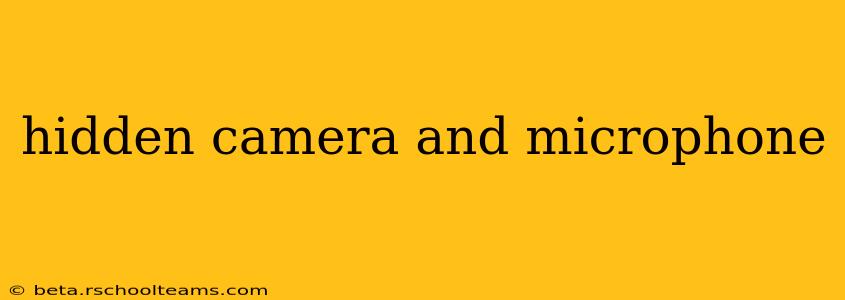The world is increasingly interconnected, raising concerns about privacy and surveillance. The potential for hidden cameras and microphones to compromise personal security is a significant worry for many. This comprehensive guide will equip you with the knowledge and techniques to detect these devices and protect your privacy.
Understanding the Threat: Why Detect Hidden Cameras and Microphones?
Hidden cameras and microphones, often deceptively small and cleverly concealed, can be used for malicious purposes, including:
- Identity theft: Stolen personal information can be used for financial fraud or other criminal activities.
- Eavesdropping: Confidential conversations can be recorded and misused.
- Stalking and harassment: Individuals may be monitored without their knowledge or consent.
- Corporate espionage: Sensitive business information can be leaked to competitors.
Techniques for Detecting Hidden Cameras
Detecting hidden cameras requires a multi-pronged approach, combining visual inspection with technological tools.
Visual Inspection: The First Line of Defense
- Look for unusual objects: Examine your surroundings carefully, looking for anything out of place, like suspiciously positioned objects or small holes. Pay attention to smoke detectors, clocks, power adapters, and other everyday items that could conceal a camera.
- Check for LEDs: Many cameras have tiny indicator LEDs that may be visible in low-light conditions. Use a flashlight to illuminate suspect areas.
- Unusual reflections: Examine reflective surfaces, like mirrors or glasses, for unusual reflections that might indicate a hidden lens.
Technological Detection Methods
- Smartphone Apps: Several smartphone apps are designed to detect hidden cameras by detecting infrared (IR) light emitted by some cameras. Remember to thoroughly research and choose a reputable app.
- Professional Detection Devices: Specialized devices, such as RF detectors, are available for detecting wireless signals emitted by cameras and microphones. These are particularly useful for finding devices that are not readily visible.
- Infrared (IR) Viewfinders: These devices allow you to see infrared light, making it easier to spot cameras that might be emitting IR signals.
Detecting Hidden Microphones
Locating hidden microphones can be more challenging than detecting cameras.
Listening for Unusual Sounds
- Listen carefully: Pay close attention to any unusual background noises or static in a room. A hidden microphone might introduce subtle hissing or clicking sounds.
- Use a white noise generator: Playing white noise can mask any audio being picked up by a hidden microphone.
Technological Detection Methods
- RF Detectors: These devices can also detect the radio frequencies used by wireless microphones.
- Signal Detectors: Professional-grade signal detectors can pinpoint the source of radio frequency transmissions.
Prevention and Mitigation Strategies
Prevention is always better than cure. Consider these proactive measures:
- Regular inspections: Regularly check your home or office for any suspicious objects.
- Strong passwords and security: Secure all your electronic devices with strong, unique passwords.
- Software updates: Keep your software updated to patch security vulnerabilities.
- Physical barriers: Strategically placed furniture or blinds can help to block cameras or microphones.
Conclusion: Protecting Your Privacy in an Age of Surveillance
The detection of hidden cameras and microphones is an essential skill in today's technologically advanced world. Combining thorough visual inspection with technological detection methods can significantly improve your personal security and protect your privacy. Remember, staying vigilant and employing a multi-layered approach is crucial in safeguarding yourself from potential surveillance. This guide provides a starting point; further research and professional advice might be necessary depending on your specific concerns.
